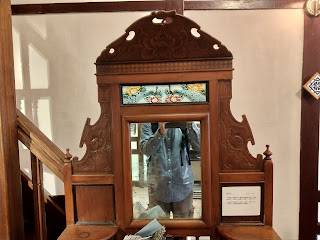The world's only tile themed Museum of Ancient Taiwan Tiles opened in September, 2016. In 2016, one of the professors who is leading a world tile-related project in French's Aix Marseille University got to know this museum in Chiayi City, so she and her team helped to apply for the tiles' recognition on UNESCO's World Intangible Cultural Heritage list. They believed that Taiwan's tiles, used as meticulous decorative finishing touches in old buildings, should be preserved as the world's best and most beautiful of their kind.
看了 #獨立特派員 #台灣老花磚 對花磚有初步認識,後來朋友提起嘉義的花磚博物館所以去參觀。
臺灣老花磚,歐洲稱為維多利亞磁磚( Victorian tile ),日本稱為馬約利卡磁磚(Majolica tile),新加玻與馬來西亞稱娘惹磚(Peranakan tile)
最初源自歐洲,日本明治維新後仿造英國維多利亞樣式,於 1915~1935年間流行於臺灣,因二戰停產而消失。是日治時代,臺灣與西方文化融合的重要歷史軌跡。
臺灣老花磚可分為臺灣手繪花磚、客製化花磚、日本與歐洲進口花磚。
彩繪磚在亞洲,這類裝飾磚起源於西方文化。 在 1868 年明治維新之後的工業化和現代化過程中,日本接觸到來自維多利亞時代英國的彩繪琺瑯瓷磚。 但是,雖然日本最早的彩繪裝飾瓷磚模仿了進口的琺瑯,但該國很快就開始生產適合其出口市場口味的圖案和設計。 例如,中國民族市場偏愛吉祥的動植物圖案,如蘋果(象徵和平)、桃子(長壽)、石榴(多子)、魚(富足)等。
Painted tiles in Asia,decorative tiles of this type have their originsin Western culture. Japan was exposed to painted majolica tiles from Victorian England during the industrialization and modernization that followed its 1868 MeijiRestoration. But while Japan's earliest painted decorative tiles emulated the imported majolica, the countrysoon began to produce its own patterns and designs tailored to the tastes of its export markets. For example, theethnic Chinese market was partial to auspicious plantand animal designs, such as apples (symbolizing peace),peaches (longevity), pomegranates (many children),and fish (abundance),along with the propitious
世界各地其實都有花磚,歐洲人喜歡用花磚裝飾浴室防水也增加美感;台灣花磚則飾於屋牆外,幾乎大部分都嵌置在眾人看得見的屋頂上。台灣花磚源自日本,因為日本明治維新運動帶動了建築形式的西化,所以台灣1915年至1930年間建造或整修的房宅都會選用花裝飾,尤其常見於當時大戶人家的屋舍。因此花磚成了炫富表徵,也呈現了台灣那個年代流行的生活樣貌。
Decorative tiles are everywhere. Europeans use them in bathrooms becausethey are beautiful and resist water. In Taiwan, they appear mainly in exteriorroofs where they are most visible. Taiwan's tiles originated during Japan's occupation of the island. Starting during the Meiji Restoration, Japan's buildingswere westernized and this trend also influenced Taiwan, and wealthy familiesthat built or restored homes between 1915 and 1930 in Taiwan generally useddecorative tiles. Thus, they became a popular symbol of wealth in that era.
當年作為日本殖民地的台灣,也收到了一些這樣的裝飾瓷磚。 但它們是一種昂貴的進口產品,僅用於裝飾富人住宅的外部,對他們來說金錢不是問題。 將這些瓷磚融入傳統的紅磚三合院,形成了鮮明的台灣美學,如雲林縣北港蔡家、台中五峰林家、台中大安黃家等。
As a Japanese colony in those days, Taiwan also received some of these decorative tiles. But they were a costly imported product used only for decorating theexteriors of the homes of the rich, for whom money wasno object. The incorporation of these tiles into traditionalred-brick sanheyuan gave rise to a distinctly Taiwaneseaesthetic, examples of which include the Tsai home inBeigang, Yunlin County, the Lin home in Wufeng, Taichung, and the Huang home in Da'an, Taichung.
早在花磚博物館成立前,就有一群人已經開始默默收集或保護台灣花磚古厝。這10多位在各領域各有專長的同好,因興趣而互相交流,花了20多年青春對花磚進行研究,並全島奔走。他們除了疼惜台灣老厝的凋零,也自掏腰包地收藏這些被世人遺忘的老花磚:這些各地古厝老故事加上老花磚,漸漸累積成一間博物館。
Before the museum opened, around a dozen people from various walks oflife were already working to protect these old, tiled homes. They spent over20 years researching and sharing information. They scoured the island for oldhouses with tiles. They cherished the old ruins and spent their own moneyto preserve the tiles. Eventually, these people, their stories, the old ruins, andtheir tiles, became a museum.





























沒有留言:
張貼留言